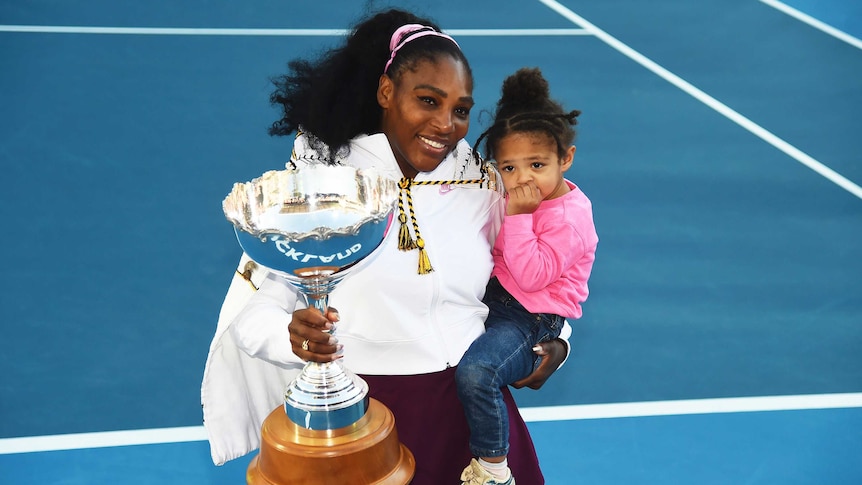As Serena Williams prepares to farewell the sport she dominated for two decades, an Australian coach has revealed the lengths young players on the women’s tennis tour are going to so they can have long careers without interruption.
Key points:
- Serena Williams said one of the reasons she will be retiring soon is because she wants another child
- Williams used 45-year-old NFL quarterback and father of three Tom Brady as an example of men who do not have to make that choice
- Australian coach Rennae Stubbs says some young women on tour are freezing their eggs to have kids after their careers
Williams flagged in a Vogue article titled Serena’s Farewell that she was not far away from ending her tennis career, hinting that it may be after the US Open, which starts at the end of the month.
The 23-time major winner said “something’s got to give” for a number of reasons; partly because she turns 41 at the end of September, partly because of her many business interests that are a full-time job in their own right, and partly because she wants to have a second child.
Williams, who was two months pregnant with daughter Olympia when she won her last major, the 2017 Australian Open, pointed out that while she “loved every second of being pregnant” it was unfair that she had to choose one or the other while most male athletes do not.
“I never wanted to have to choose between tennis and a family. I don’t think it’s fair,” she said, pointing to 45-year-old father of three Tom Brady, who retired as an NFL quarterback and then un-retired last off-season.
“If I were a guy, I wouldn’t be writing this because I’d be out there playing and winning while my wife was doing the physical labor of expanding our family.”
Former doubles world number one Rennae Stubbs told Radio National Breakfast that many players on the WTA tour were exploring fertility options early in their careers so they could play tennis for a decade or more without missing their window to have kids.
“I know players who want to have children, who want to have a family, have [frozen] their eggs, because they want to play until their mid-30s or 40s,” Stubbs, who coached stars Sam Stosur, Karolína Plíšková and Eugenie Bouchard, said.
“And there’s so much money in tennis now, they want to keep going and they can sustain themselves and their families.
“So they freeze eggs so they can have kids later on in life. But think about Tom Brady or Roger Federer or Rafa [Nadal] now; you can have children and keep playing because you’re not the one birthing it and taking nine months to have the child and then the recovery after the child.
“There’s no question that it’s way more difficult for women. No question about it.”
It is not only globe-trotting tennis players who have made the decision, with WNBA stars Sue Bird and Breanna Stewart, English Super Netball player Geva Mentor and USWNT forward Sydney Leroux speaking openly about their egg retrieval processes.
In a post on the Reproductive Health and Wellness Center’s website about UFC fighter Carla Esparza freezing her eggs, the Orange County-based IVF and fertility experts wrote that the procedure is becoming increasingly “popular with young professional women who lead busy, active lifestyles and don ‘t want to run the risk of waiting too long before starting their family for fear of egg viability.”
“Women in the professional athletic field often face the risk of fertility issues frequently, as the nature of intense athletic professions may put women at a higher likelihood of irregular ovulation,” the website reads.
“Women who exercise frequently and/or are athletes are often at risk for irregular ovulation and fertility issues later in life due to the intense physicality their bodies are put through. When their bodies are physically strained, the brain will not stimulate the ovaries in a normal way.
“For those who have a passion for intense exercise or make it their primary job, having to keep fertility in mind while also keeping one’s body as fit as possible is a difficult balance.”
Returning to sport after having a baby
AFLW superstar Erin Phillips and Australian fast bowler Megan Schutt have both continued playing while their partners gave birth to their children in recent years.
But tennis and other sports are full of women who sat out long periods of their athletic prime to start a family, with comebacks sometimes yielding further success and sometimes not.
Belgian great Kim Clijsters stepped away while ranked in the top five in 2007, had her first child the next year and made a triumphant return, winning three more major titles from 2009 to 2011.
Williams herself has been strong but not her usual dominant self since coming back in early 2018, having endured a difficult birth with Olympia, including a pulmonary embolism and postpartum depression.
Having played in all but two of the 10 major finals leading up to her break from tennis, winning six titles in the process, Williams has reached four deciders since her comeback and has been unable to win one to reach the record 24 singles titles won by Margaret Court across the amateur and Open eras.
Coincidentally, on the same day Williams’s Vogue article was released, 41-year-old Australian basketball legend Lauren Jackson was named in the Opals’ squad for the World Cup, which starts in September.
Jackson stepped away from the game in 2016 and raised her two sons, before making a comeback earlier this year.
Basketball Australia (BA) has had a spotty record with working mothers at times, engaging in a childcare dispute with Abby Bishop, who has custody of her sister’s child.
BA initially said Bishop would have to pay for flights, care and accommodation for Zala, leading to Bishop taking time away from the national set-up until the dispute was resolved in 2015.
.
